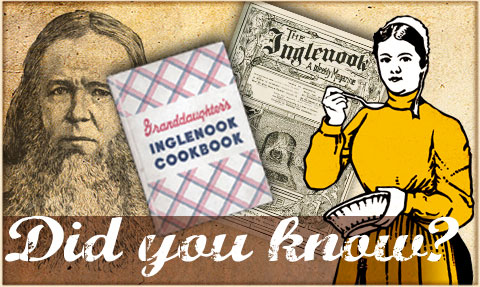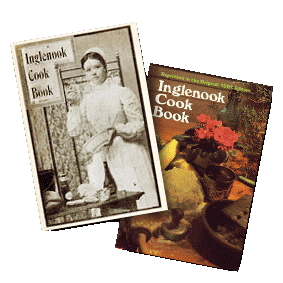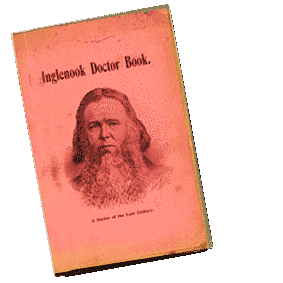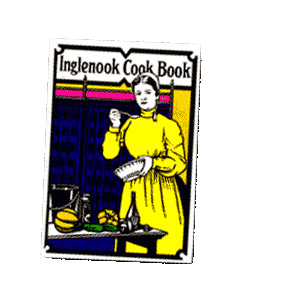Did you know?

 Inglenook Magazine
Inglenook Magazine
The Inglenook was a weekly magazine published by the Brethren Publishing House (now Brethren Press) from 1900 until 1913. It was a continuation of The Pilot, a “literary weekly” geared toward the education and entertainment of youth. The Inglenook wasn’t just for youth; its wholesome content was for young and old alike: “Its pages are clean, its articles instructive, and it is a fitting companion for the spare moments of the schoolboy and the gray beard.”
The Inglenook featured educational articles on nature, travel, and history, counsel on managing life at home, commentary on current events, and brief sermons and Sunday school material. It also had witty segments called “Funnygraphs” and paid advertisements for a wide range of products and services—from the most innovative balms and elixirs for whatever ails you to real estate schemes enticing readers to go west. The Inglenook had it all, for one dollar a year.
1901 Inglenook Cookbook
The Inglenook Cookbook was first published by the Brethren Publishing House (now Brethren Press) in 1901. It was a collection of 1,000 recipes contributed by the women of the Church of the Brethren, a Christian denomination known for peace, simplicity, and service. And good cooking!
The cookbook was given to subscribers of The Inglenook magazine. An issue from June 1901 promised this was the only way to get a copy: “It will be given to subscribers to the Inglenook, and it can be had in no other way for love or money. It will not be put on the market, and he or she who wants it must be a ’Nooker.”
The woman on the front cover—lovingly called the “Inglenook Girl”—has become synonymous with the Inglenook brand. A few years ago, the editor of our denominational magazine, Messenger, found out who she was. Read his discovery here.
This first edition of the Inglenook Cookbook, complete with original advertisements, was reprinted in 1981 with a new cover.
1903 Inglenook Doctor Book
The Inglenook Doctor Book was compiled and published in 1903 by the Brethren Publishing House (now Brethren Press) in a format similar to the Inglenook Cookbook. The idea for the book sprang from the knowledge that there were tried-and-true remedies for diseases and ailments hidden away in the private homes of Americans that needed to be shared just as much as recipes might be exchanged.
The Inglenook Doctor Book contained 916 home remedies for common problems like colic and tonsillitis to more serious illnesses like cholera morbus and neuralgia.
The book shied away from the efficacy of the remedies and ointments contained in the book: “There is no guarantee of the effectiveness of these remedies on the part of the Inglenook. It is not even claimed that they are scientific, but they do represent successful experience which in practice is worth more than science.”
The Inglenook Doctor Book was reprinted in a paperback edition in 1975 by The Brethren Press and Pyramid Publications.
1911 Inglenook Cookbook
In 1911 a new revised edition with even more recipes was published by the Brethren Publishing House (now Brethren Press). The cookbook continued its appeal to Brethren families, still mostly rural, who wanted substantial meals simply and tastefully prepared.
The new edition contained almost twice as many pages as the 1901 edition, and the publishing house received complaints that the new edition was too bulky. In a February 1911 column, the editor responds to this criticism by sharing the main reason behind the larger size. As a new feature, the recipes were arranged in such a way that there was no need to turn a page when using a particular recipe. “It is possible that other cook books contain this feature, but we have never seen them and never thought of it before; the idea is as much ours as if it had never been thought of before by any one.”
Despite some early criticism, the revised edition became even more popular than the 1901 edition. Both editions were “bestsellers” of their time, selling more than 100,000 copies combined.
The photograph of the Inglenook Girl on the cover was turned into a colorized drawing for the 1911 revised edition.
This edition has had two major reprints—in 1970 and then again in 1974 as a mass market paperback by Pyramid Publications.
1942 Granddaughter’s Cookbook
By 1940 the children of those who supplied and used the recipes from the first two cookbooks were ready for their own—one that reflected their practical experience and included recipes fit for modern diets. There was a growing concern that increased urbanization coupled with technological advancements in farming was causing a deficiency in the wholesome and simple diet many Americans were used to. A cookbook advertisement from a November 1941 issue of the Gospel Messenger touched on this sentiment, encouraging folks to make a difference by contributing to a new cookbook: “Many Americans are literally starving in the midst of plenty because they are not giving attention to wholesome economical cooking. We believe the practical cooks in our church can make a contribution to a more nourishing diet.”
In 1942, thanks to over 5,000 recipe submissions, the Granddaughter’s Inglenook Cookbook was published. It included several new features—charts and tables providing guidelines for such things as measuring food, distinguishing between cuts of meat and how to cook them, and determining processing times for canning various foods. It also had an extensive index. It originally sold for one dollar a copy.
The cover has changed from the original red, white, and blue plaid cover of 1942 to the idyllic drawing of the rural farmstead of 1976.
Several variations of this edition have been published since 1942, with major releases to the general public by Harper and Brothers in 1948 and by Two Continents in 1976.
Inglenook store
Kitchen scrapbook
About Inglenook
Wit & wisdom
Grandmother’s kitchen
Did you know?

